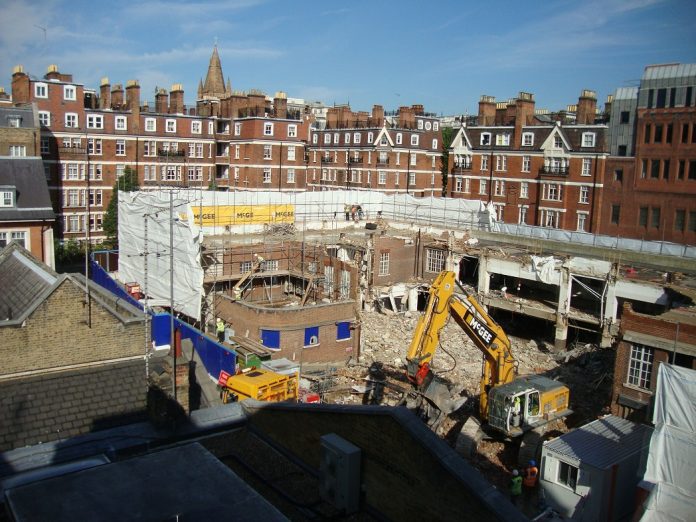WSP | Parsons Brinckerhoff’s Martin Raisborough explains the difference between Section 61 consents and Section 60 notices in relation to construction noise
Section 61 consents are often granted by local authorities for projects that generate noise during the demolition and construction phases, but do applicants know the advantages and disadvantages of the consents and why they are applying for them?
Part III of the Control of Pollution Act (CoPA) 1974 relates to noise, with two sections, Section 60 and Section 61, focussing on construction noise – i.e. that from engineering construction and demolition activity.
CoPA is primary legislation – i.e. it is an act of Parliament. Any appeal to a Section 60 notice or a Section 61 consent must be via the magistrate’s court. The two sections approach construction noise very differently, and it is important that developers and contractors understand the differences.
Section 60 – Control of noise on construction sites
Section 60 of CoPA grants power to a local authority to serve a notice on a developer or contractor imposing restrictions on construction works. Conditions may be imposed at any time and without prior warning or consultation, although it is usual for local authorities to engage with developers prior to serving a notice.
A Section 60 notice is normally served in response to complaints from nearby sensitive properties affected by the construction works such as a dwelling, place of worship or education facility. Although it rarely happens, the local authority can impose restrictions on a contractor before the commencement of work if it believes there will be a high likelihood of complaints being received.
The notice may restrict demolition and construction activities in a number of ways, including specifying the type of plant that can be employed, the times of the day when certain plant or activities might be undertaken, the hours of general site operation or the level of noise that may be emitted from the site. If the notice is contravened, there is likely to be a financial penalty.
The notice may prescribe alternative methods, plant or machinery which a local authority believes would minimise noise to an acceptable level to allow construction works to continue.
Section 61 – Prior consent for work on construction sites
Section 61 of CoPA describes the process of applying to the local authority for consent prior to works commencing.
The consent is entered into by a developer/contractor and the local authority in respect of noise from a construction site. Consent is granted based on the exact details provided in the application. As long as the construction site operates as set out in the application, the local authority cannot serve a Section 60 notice.
While CoPA requires only a small amount of information to be submitted with a Section 61 application, some local authorities request varying levels of information which often means that the process needs to be initiated up to two to three months before works start. The statutory determination period for the local authority is up to 28 days.
CoPA effectively requires developers to minimise noise to acceptable levels wherever possible. The interpretation of acceptable noise levels should consider the existing baseline noise climate (before construction) and how the work is being carried out. The former requires an early programme of noise monitoring on and around the construction site, while the latter requires consideration of ‘best practicable means’ – “having regard amongst other things to local conditions and circumstances, to the current state of technical knowledge and the financial implications”.
Applying for a Section 61 Consent
It is usually necessary to appoint an acoustics consultant to undertake baseline noise monitoring and to provide detailed calculations to anticipate the noise climate during demolition/construction. They should also be able to provide expert advice in relation to ‘best practicable means’.
Detailed information on the construction process will be required, including a programme of activities, method statements, type and number of plant and the hours of operation. Depending on the outcome of the calculations, the acoustics consultant should be able to advise on alternative techniques that might reduce noise levels and/or other mitigation measures that may need to be considered.
Once the above has been completed, the application can be submitted to the local authority and, if required, the acoustics consultant can liaise with the local environmental health officer on the technical detail.
Why Apply for a Section 61?
The Section 61 process is generally recommended for contentious sites, those where abnormally high noise levels are anticipated or where particularly noise sensitive properties are nearby.
A well developed and negotiated Section 61 consent provides developers and contractors with relative certainty that their works can progress uninterrupted. It is also advantageous to the local authority, allowing them to engage with developers and contractors at an early stage to establish good lines of communication and to be reassured that due consideration is being given to the potential for noise disturbance to arise.
This in turn has the added benefit of minimising the likelihood of costly programme delays as a result of the local authority imposing restrictions as a result of noise and/or vibration.
What are the cons?
An overly descriptive Section 61 application may become restrictive to the developer and local authority. It is essential, therefore, that a balance is struck between protecting the amenity of any neighbours while allowing developments to progress. This can often be difficult, and careful and detailed negotiation and dialogue is often required between the two parties.
How is a Section 61 agreement policed?
There are a number of ways a Section 61 consent can be policed such as demonstrating that mitigation measures have been implemented, particular plant items or construction techniques have been adopted and/or monitoring of noise and vibration levels, particularly during any contentious works.
The Section 61 consent may specify that regular liaison meetings are held with certain stakeholders. Such meetings allow for good communication between neighbours and the developer which is key to maintaining good relationships and minimising the potential for complaints.
A programme of noise and/or vibration monitoring for the duration of the more contentious construction work is a common way to demonstrate compliance with the consent. The monitored levels are usually provided to the local authority (and sometimes other interested parties), giving assurance that work is being undertaken as consented and in a responsible manner.
 Martin Raisborough
Martin Raisborough
Board Member
Association of Noise Consultants
Senior Technical Director, Acoustics
WSP | Parsons Brinckerhoff














